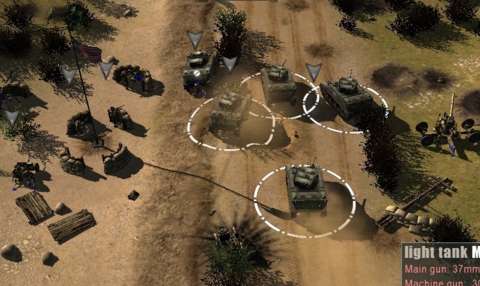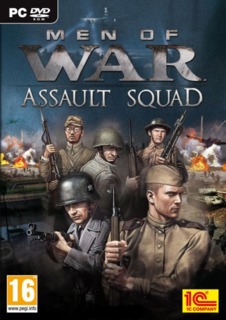INTRO:
The original Men of War was a terrifically complex game that surprised some followers of the computer platform with its sophistication. It also happens to be made by a developer that reiterates and recycles over and over, so it is not a surprise that there would be another so-called stand-alone expansion for Men of War after Red Tide, and then another, this time named “Assault Squad”.
However, where Red Tide focused on telling the stories of the exploits of soldiers that made a difference in World War II, Assault Squad is practically a primer for the next evolution in the series’ unforgiving multiplayer.
No more will the player shepherd a plucky group of soldiers that do whatever they can to hold back the powerful enemy. Instead, the player will have to be a lot more cavalier than he/she had been when playing Men of War’s story campaigns.
SKIRMISH MODE:
Unlike the previous Men of War titles, Assault Squad does not have any story-based campaign to play through. Instead, the player plays facsimiles of important events in World War II. These facsimiles take on the form of maps that have the player starting out with only small portions of them under his/her control, and he/she will have to take the rest from whoever the enemy is. The maps may have the name of important locales in the history of World War II, but this is just a cosmetic design.
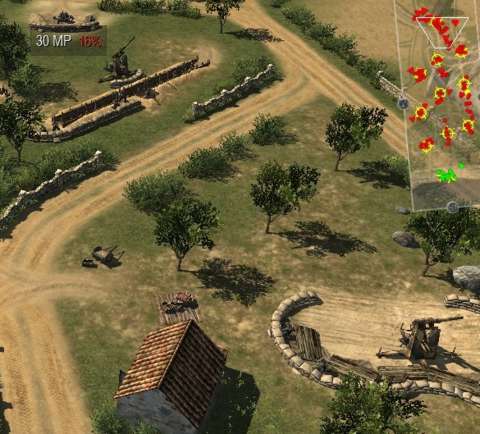
Within any skirmish map, there are a handful of strategic points that the player needs to capture; this is a feature that had long been in real-time strategy titles with World War II settings, the earliest example being Close Combat. Anyway, as to be expected of such a system, the player must capture and hold these points in order to win. It is a system that generally worked, and Assault Squad fortunately does not break it.
Keeping itself more in line with present-day interpretations of this system, these strategic points are needed by the player in order to obtain the “resources” that are necessary to requisition reinforcements. Such a system may seem all-too-familiar to veterans of the multiplayer experiences of the Men of War titles.
With that said, the single-player mode in Assault Squad is definitely not for fans of the series that preferred its campaigns.
REQUISITION:
The system of requisitioning reinforcements is the most important aspect of the gameplay. It is in the best interest of any player to keep this in mind – including players that prefer to handle a finite group of soldiers, like they had in the story campaigns of previous Men of War games.
The player is given a counter and some menu tabs at the right hand side of the user interface (UI); such UI elements would be quite familiar to veterans of the previous Men of War games. (It also appeared in certain story-based missions in the previous games.)
Through this UI element, the player spends points in the counter to summon in reinforcements. There will be more elaboration on reinforcements later.
If such is the case in skirmish mode or any co-op session against the A.I., the player has lost already. The reason for this will be described later, because it concerns settings that influence the A.I.’s capabilities.
Having more strategic points increases the rate at which he/she accrues requisition points. However, there are a couple of major limitations that prevent the player from abusing this.
Firstly, there is a ceiling limit to requisition points. If the player hits this ceiling by not spending any points, any points that are accrued from then on are wasted.
Secondly, having units and hardware on the field applies a penalty on the accrual rate. Having more units and hardware increases the penalty. The hardware that the player captured from the enemy and brought into operation also contributes to this penalty.
Therefore, the only way for the player to build an overwhelming army is to somehow preserve the lives of as many soldiers as possible while disabling and recovering enemy equipment – this is not possible without cheating in Assault Squad.
Nevertheless, it is in the player’s interest to capture as many strategic points as possible. In the official skirmish maps, any strategic point is associated with the unlocking of more reinforcement options. For example, a strategic point with an icon of an armoured vehicle above it will unlock armoured vehicles for requisition. The last and furthest strategic point also happens to be the one that the player must capture to achieve eventual victory.
REINFORCEMENTS:
Reinforcements that have been requisitioned by the player appear from the edge of the map that the player started at, eventually working their way towards where the player directed them to.
The reinforcements will take the quickest route to where they need to be, making use of any roads (which help vehicles move faster). This means that they can run afoul of any opposition that the player has not cleared from the vicinity of their routes, or has moved in after the player has neglected to establish lines of defences (more on this later).
Fortunately, once reinforcements enter the map, they are considered as being under the player’s control already. Therefore, the observant and attentive player might be able to notice that reinforcements are going into harm’s way or possible ambushes at where the player does not have eyes. (This would require the player to monitor the mini-map of course.)
Although there does not appear to be any upper limit on the number of units that the player can have in the field, it is not easy to maintain a sizable army because, much like the previous Men of War titles, most units are fragile or vulnerable in one way or another. Mistakes can cost the player dearly, and any requisition points that the player may have accrued may well be spent on getting replacements.
SUPPORT OPTIONS:
Some of the reinforcement options are not exactly reinforcements, but rather off-map support such as airstrikes and artillery bombardment. These understandably have long cool-down times, but if the player can place them optimally, he/she can eliminate a lot of resistance in just a short time.
Unfortunately, the factor of luck is significant in determining the effectiveness of these strike options. Where the hits occur is randomly determined; if the player is very unlucky, they might not hit anything at all. Instead, they just create craters that give more cover to the enemy.
INVENTORY & SUPPLIES:
The inventory system for individual soldiers and vehicles that was seen in previous Men of War games return in Assault Squad, but it is no longer as important in this entry.
This is because of the prevalence of reinforcements in battle plans now. If the player tries to trick out individual units with loads of gear like he/she could in previous Men of War titles, he/she would learn the hard way that the time and effort – even with the use of game pauses – spent doing so is just not worth the opportunity cost incurred from not having spent that on actually considering the player’s overall strategic situation.
The player will still need to consider the ammunition and supplies that units have though. Individual units still only start with limited amounts of supplies and equipment. However, the player can be more cavalier in Assault Squad than he/she can be in previous games. As an illustrative example, if a player has noticed that a squad is running low on ammunition, he/she can manually have them rummage through corpses that are near them for some more; chances are that formerly-alive comrades with compatible equipment are more than likely to be around them.
Also, ammunition for small arms are still very much universal; rifle rounds that can go into a Mosin can go into a Mauser, for example.
Vehicles are a bit more troublesome to resupply though. The supply trucks that any player can call in usually stock supplies for light arms and small-calibre heavy weapons; they hardly if not never carry tank shells. This means that vehicles, especially tanks, have to obtain resupplies from knocked-out ones of the same model, or at least from tanks with cannons that use the same calibre of rounds.
REDESIGNED VEHICLE DURABILITY & REPAIRS:
In the previous games, vehicles are rather flimsy things; they are simply knocked out and rendered irrecoverable if they are hit by weapons that can penetrate their hull.
In Assault Squad, they are a lot harder to be put out of commission permanently. One of the reasons for this change is that vehicle hulls are not considered immediately destroyed when pierced. The hulls can be repaired, given enough time (which is several very long minutes), and the vehicles can be returned to service.
However, there can only be so many knock-outs that a refurbished vehicle can suffer. Eventually, it will be knocked out for good. This means that the operation of captured vehicles carry their own risks.
There are also a few new designs in place to prevent the wily player from abusing these relaxed rules on vehicle durability.
The first of these is that if either the turret or the hull of a vehicle is damaged, it is rendered completely immobile. The player cannot damage the turret of a tank to force its crew out, and then commandeer the vehicle and drive it away to somewhere quieter to be repaired. (Incidentally, the player could do this in the previous Men of War games.)
This means that the player must defend a knocked-out vehicle from encroachment while a soldier slowly repairs it, which is easier said than done.
Furthermore, if the player is relying on a strategy to build up a fleet of captured vehicles, he/she may find that the resources that have been expended on defensive measures to do this would have been better spent on actually attacking the enemy with fresh assets in order to gain ground as early as possible.
RETURNING SHORTFALLS:
Speaking of vehicles, they remain as clumsy as they were in previous Men of War games. They are also still vexed by the terribly lousy pathfinding of their drivers and the sometimes schizophrenic targeting skills of their gunners.
These are not the only issues that return from the previous Men of War games. Even on foot, the soldiers still have lousy pathfinding that can have them straying into the vision arcs of machinegun nests.

The lack of user friendliness in the previous Men of War titles is here in Assault Squad too. To cite some examples, the player still cannot do anything to highlight the queue of orders that he/she has given to units and the player still has to micromanage units’ ammunition supplies. Refuelling also remains a finicky process of equipping cans and barrels.
The most infuriating returning issue is that shooting is still affected by luck. Shots still can either stray widely at long distances, or score fortuitous hits. It can be aggravating too if some stray shot that has been fired by the enemy lands on something important far behind the front lines.
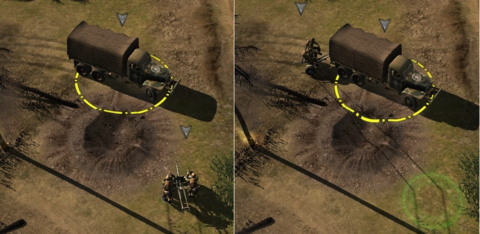
MINOR IMPROVEMENTS:
Not all of the problems in the previous games return, fortunately. Some has been addressed.
In the previous games, the player could have a single soldier enter a small building, and then the interior of all buildings will be revealed to the player. This is not so in Assault Squad.
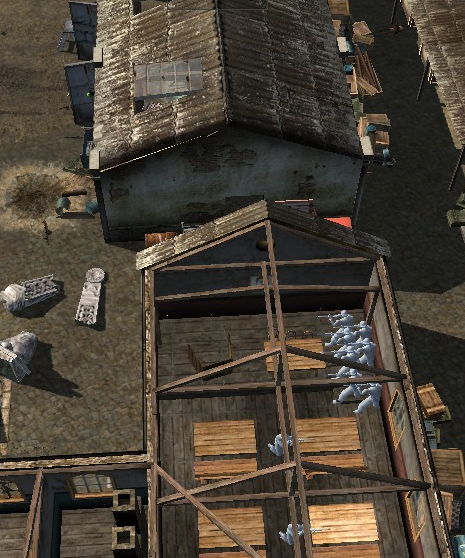
Chief of these improvements is that infantrymen will no longer forget to rearm themselves after dropping a weapon after being knocked down. A soldier that is missing a weapon will seek out a replacement if it is several feet within range, picking the one that he is most proficient in if there are more than one. This improvement could have been even better if it is extended to picking up ammunition from containers or corpses, but a soldier only picks up loose objects on the ground.
In Assault Squad, Infantrymen are no longer immediately killed when their hitpoints drop to zero. Thanks to handy morphine packs (they are called such in-game, unsettlingly enough), they can be brought back quickly to half their health capacity. Soldiers on foot dying too easily were a sore point in previous games, so it is fortunate that the developer has implemented a work-around. Granted, this will take a lot more micromanagement, so this feature cannot be so easily abused.
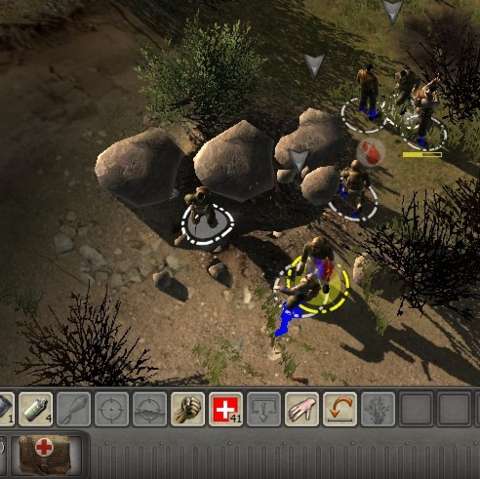
Infantrymen also seemingly run for longer distances in Assault Squad. This is good, because the player will be relying on infantry to do many things, chief of which is to capture the strategic points (which have indestructible sandbag defences, by the way).
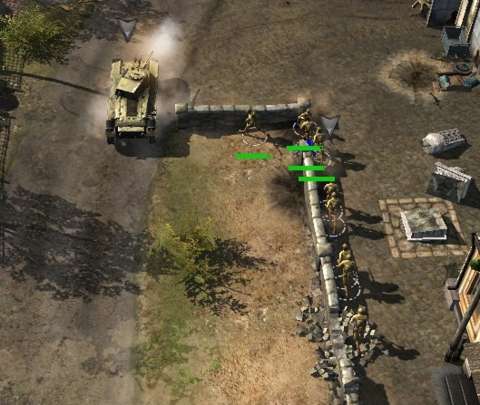
A.I. OPPOSITION & ALLIES:
Like in the previous games, A.I.-controlled units get a lot of crutches to compensate for their stupidity. The most important of these is unlimited ammunition.
This means that painfully powerful A.I.-controlled enemy artillery will never stop firing, which means that they can practically lock down an approach indefinitely until the player comes up with a counter.
In certain skirmish maps, such as the first one for the Japanese faction, A.I.-controlled allies are worked into the list of requisition options. These options do not put units under the direct control of the player, but instead places a substantial number of units under the control of the A.I., which subsequently sends them into the meat-grinder of the front-lines.
This may seem wasteful, especially considering that losses suffered by A.I.-controlled allies are counted in the final scoring as well. However, as mentioned earlier, the player has to be cavalier about taking losses. The A.I.-controlled allies happen to make very good meat-shields for the player’s own troops, who can use the afforded cover to capture points.
(By the way, A.I.-controlled allies cannot capture points. This is not told to the player.)
In most of the official skirmish maps, the A.I.-controlled opposition has access to periodic but never-ending reinforcements. These get more frequent and severe as the player captures more strategic points. Losing strategic points to counter-attacks will not lessen the ferocity of enemy reinforcements. The difficulty setting that is used also determines the severity of these reinforcements, among other things that will be described later.
Fortunately, for most of the official skirmish maps, the reinforcement and support options that the player would immediately unlock from capturing a strategic point happen to be the most efficient at capturing the next nearest strategic points.
Of course, the player will need to reserve some requisition points to immediately make use of this. The game does include some in-game hints that suggest to the player that he/she should do this.
FACTIONS:
There are up to five factions that are featured in Assault Squad, and all of them had been in previous Men of War games before: the Soviet Union, the USA, the UK, Imperial Japan and Nazi Germany.
Most of their hardware had been seen in the multiplayer modes of previous Men of War titles, so there would be little to nothing new that had not been seen before. There may be something to be seen from the reinforcement and support options, some of which are very entertaining. Examples include the Banzai attack force and storms of rockets.
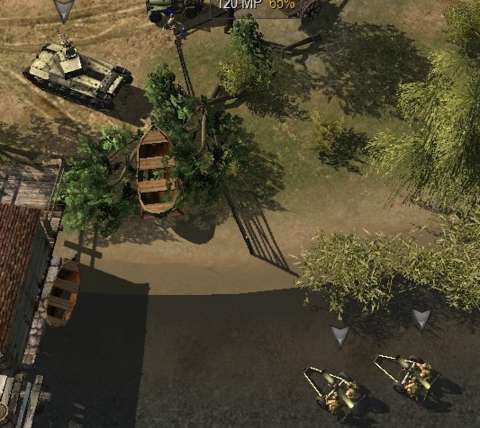
DIFFICULTY SETTINGS:
When playing a skirmish map, either in single-player or multiplayer, the player (or hosting player, in the case of multiplayer games) can pick the difficulty setting of the A.I.
The difficulty setting of the A.I. does not determine its cleverness, which is unfortunate for players who are expecting more sophistication; any cleverness that the A.I. has is worked into the scripts for the particular map, which will play out regardless of the difficulty setting that has been chosen.
The setting instead determines the penalties that are levied on the capabilities of the units under the enemy A.I.’s control. They are terribly clumsy and could barely hit the broad side of a barn on the easiest setting, and they do very little damage when they hit. On the highest difficulty setting, all these penalties are removed.
However, the player is not fighting on a more level field at the higher difficulty settings. These settings happen to cause the enemy A.I.’s reinforcements to become more frequent.
Any difficulty setting that is higher than “Normal” happens to hide the presence of enemy units that the player has not scouted out. Once they have been detected, they are always visible to the player, but the player will not otherwise know that reinforcements are on route (though the player should always expect that on the higher difficulty settings).
The higher difficulty settings can make for terribly unpleasant experiences, but they are there for those players who think that they have something to prove.
If there is anything that is unarguably problematic with the difficulty settings, it is that they are set to the nastiest, “Heroic”, by default, and almost always reset whenever the player looks up the list of Skirmish maps in single-player. Furthermore, if the player chooses to play the next mission after completing the previous one when prompted, the game sets the difficulty setting to Heroic.
New and unsuspecting players may have to learn this the hard way.
BONUS MISSIONS:
Since the launch of the game, there had been a couple of “bonus” missions that have been included as free updates for the Steam version of the game (which is the only version of the game for the computer platform).

They are intended as gifts of gratitude for customers, but a sceptical player may have the impression that they are little more than afterthoughts.
Compared to the official maps, the maps in the two bonus missions are very simple, with little if any opportunities to come up with tactics that make use of terrain. Furthermore, their objectives lack sophistication when compared to those in the campaign missions of the previous Men of War games.
Of course, one could argue that the bonus missions are intended for hilarity and absurdity, but even so they would seem quite tame to players that have played games with a more outrageous sense of humour.
MULTIPLAYER:
Assault Squad, like its predecessors, comes with a multiplayer mode that has players fighting pitched battles against each other (or the A.I. – more on this later) while being subjected to the unforgiving and complex gameplay designs that the series has been known for. Assault Squad’s multiplayer happens to benefit from the minor improvements that have been mentioned earlier.
The match types are standard-fare. They may have been disguised with fanciful names that otherwise befit the settings of the game, but more experienced players would notice that they follow the staple. For example, there is “Day of Victory”, which is technically a King of The Hill match type.
Nevertheless, there is still fun to be had from Assault Squad’s multiplayer mode, even if it seems rather familiar. For example, levelling a deserted suburban town in furious house-to-house fire-fights can be satisfying (even if it does seem morbid).
Like in the previous Men of War titles, Assault Squad allows players to play in cooperative matches, specifically in the official Skirmish maps. Considering that the official Skirmish maps in Assault Squad can be rather gruelling even when compared to the campaign missions in earlier Men of War titles, playing them in co-op is perhaps the best way to beat the skirmish maps.
In fact, a co-op skirmish match can have up to 8 players going against the A.I. defenders. These many players are certainly needed if the A.I. is set to the nastiest difficulty setting. Considering that each player gets his/her own counter of requisition points, this is an advantage that will come in handy for prevailing at the “Heroic” setting.
That multiplayer in Assault Squad requires the use of GameSpy accounts may be a problem. Although GameSpy is not exactly broken, Digitalmindsoft could have opted for Steam's built-in multiplayer services instead.
(Of course, one could argue that would mean that Digitalmindsoft has to put in more effort to design the multiplayer aspect of the game around Steamworks instead of handling the multiplayer infrastructural support work to GameSpy.)
GRAPHICS:
Assault Squad runs on the same engine that powered the previous games, but it appears to be a lot more stable this time around. This could be due to the much more optimized official maps in Assault Squad instead of actual improvements to the game engine, but this is still a commendable change.
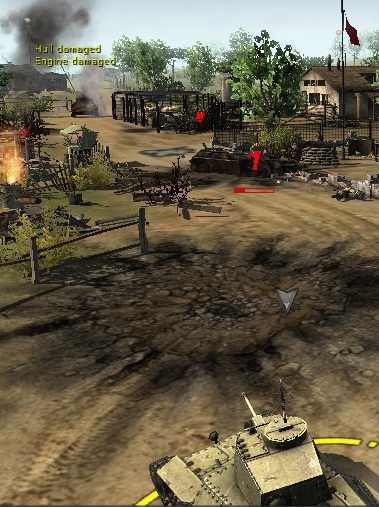
Speaking of the official maps, these surprisingly have a lot of detail for maps that are not intended for story-based campaign missions. This perhaps has to do with the various twists and turns in the map that allow for many different approaches, which means that the maps already inherently have considerable detail. With this as the foundation, the map designers have added in more details, such as buildings of various recognizable shapes and sizes.
Watching things blow apart was a particular source of joy in previous Men of War titles; that would be no different in Assault Squad. Vehicles still blow up spectacularly, spewing shrapnel that can injure nearby soldiers. Buildings can crumble under intense fire, and the debris from this can injure any unprotected person too.
Although it is supposed to be a tragic sight, it can be satisfying to watch what was once a quaint little seaside town being torn down to smoking rubble.
The most notable difference in graphics that Assault Squad has compared to its predecessors is that most of the icons that are used for the inventory system have been replaced with hand-drawn 2D artwork instead. In previous games, the icons used textures that are dependent on the player’s settings for textures. They are independent of these settings in Assault Squad, so noticing which items are which based on their looks is not an issue in this entry of the series.
VOICE-OVERS:
Although Assault Squad is a much more technically and cosmetically refined game than its predecessors, it does not do better in the aspect of voice-overs.
The best voice-overs for the Men of War games are those for the Russian ones, and unfortunately Assault Squad will not buck this trend. The voices for English-speaking soldiers still deliver the same cheesy lines that have been heard since the first Men of War game.
The worst voice-overs to be heard in the game are those for the announcers. The same male voice that has been narrating events in the USA campaign of the original Men of War is here in Assault Squad. He reads aloud the player’s progress in every official map – regardless of whether it is for the USA faction or not.

For example, it can be awkward listening to the obviously North American-accented voice uttering venerations to the Emperor of the Sun when exhorting the player to great glory in the first Japanese skirmish map.
It would be difficult to accuse the game designers for not having invested effort in doing research on what the non-English-speaking soldiers would say. As an illustrative example, the Japanese voice-overs do sound fitting and convincing, though they are seemingly provided by only a single voice-actor.
SOUND EFFECTS:
Most of the sound effects in the game had been recycled from the previous games. However, this is not a bad thing, because the sound effects that were used in previous games are already very satisfactory and convincing.
MUSIC:
The Men of War series may have recycled many aesthetic assets, but at least it has not recycled its music too much. Assault Squad would not be breaking this trend.
However, the series had a tendency of only having a few orchestral tracks for each title, and Assault Squad will not be an exception in this matter either. However, what tracks there are happen to be appropriate to the theme of glorious and suspenseful battles that Assault Squad has. This is to be expected of a Men of War title.
CONCLUSION:
Assault Squad may not be a continuation of the series’ supposed emphasis on the heroic sacrifices of heroes in the terrible times of World War II, but it is still a solid entry to the series where gameplay sophistication is concerned.
